- Quick, which has more iron: the tomato sauce or the meatballs?
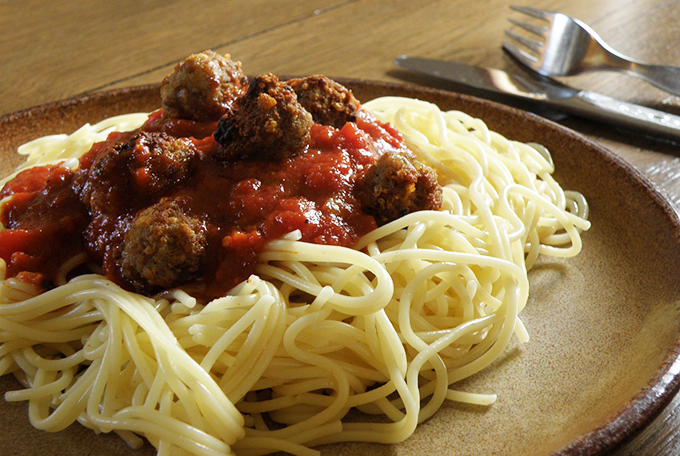
Photo by Maky_Orel via Pixabay
Did you guess the meatballs?
Well, get ready…
…The tomato sauce wins.
Veggies pump iron
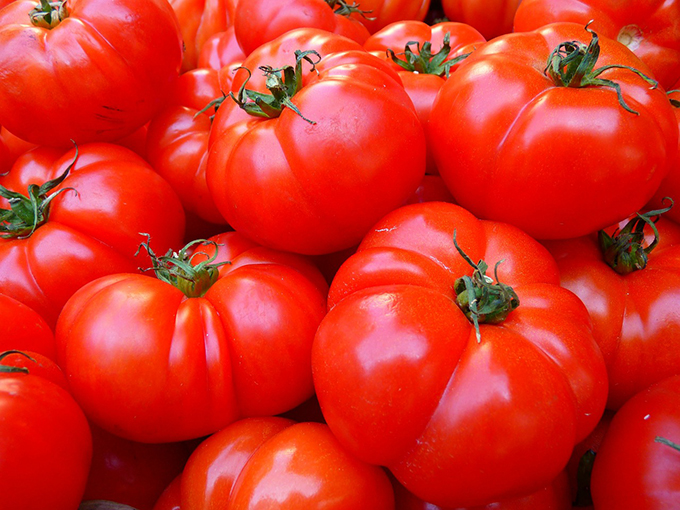
Photo by LoggaWiggler via Pixabay
You read that right: A cup of tomato puree has 4.5 mg iron, whereas 3 ounces of Italian-style meatballs contains just 1.5 mg.
I know, I was shocked too! In fact, I never would have guessed it if I hadn’t done this post at the request of fellow plant-based food blogger Miss Polkadot. (Thanks for the great suggestion!) 🙂
Anyhow, it turns out lots of vegetables are loaded with iron.
(Is anyone else envisioning a tomato flexing little veggie arm muscles like Ah-nuld? Da gym is dat way!!!)
The safest way to get your iron
Better yet, the iron found in vegetables and other plant-based foods is the safest form of iron you can eat. Why?
Heme iron, found only in animal products, is absorbed even when your body’s iron stores are full. That’s bad, because excess iron in the body can generate dangerous free radicals. High iron stores have even been linked to cancer.1
The non-heme iron in plants? Your body absorbs it only when needed. So if you’re low in iron, your body can snap it up in a jiffy. If you’re all stocked up? Your body can politely say “no thanks.” How cool is that?2
Of course, the iron in plant-based foods is harder to absorb, thanks to fiber and other plant materials. Luckily, veggies (and fruits) have a trick up their sleeve to help you get the iron you need.
Vitamin C boosts iron absorption
Vitamin C, abundant in vegetables and fruits, helps you absorb iron from plant foods. In fact, just 70 mg of vitamin C—the amount found in a medium orange or ¼ of a yellow bell pepper—can increase absorption of iron from plant foods by up to 600%!2 That makes plant-based iron almost as easy to absorb as iron from animals—without the risk of absorbing too much.
#PlantBased tip: Eating foods rich in vitamin C helps you absorb more iron! Click To TweetHow much iron do you need?
Since plant-based iron is harder to absorb than heme iron from animals, vegetarians are advised to consume extra iron. Here are the U.S. recommended daily allowances (RDAs):

Iron Recommended Daily Allowances (National Institutes of Health)
Luckily, getting enough iron is easy when you eat plenty of iron-rich, plant-based foods—including vegetables! (To learn even more about iron on plant-based diets, check out Iron in the Vegan Diet from the Vegetarian Resource Group.) In fact, I’ve never been anemic or iron-deficient on a plant-based diet.
Ready to pump some iron with veggies? Let’s do this!
Note: All data from the USDA’s National Nutrient Database, Release 28.
16 Iron Rich Vegetables
1. Spinach
Popeye was right: You really are strong to the finish when you eat your spinach! Cooked spinach has a whopping 6.4 mg of iron per cup. And contrary to popular belief, at least one study found that the oxalate in spinach doesn’t interfere with iron absorption.3 (Although the calcium and other phytochemicals in spinach can decrease absorption somewhat.) So be sure to eat spinach with vitamin-C-rich fruits and veggies for maximum iron. (6.4 mg iron per 1 cup boiled, drained spinach)
2. Hearts of palm
I know, I didn’t expect this one either! But canned hearts of palm are loaded with iron. Try some on your salad tonight! (4.6 mg per 1 cup canned)
3. Edamame (green soy beans)
Not only is edamame rich in calcium (#2 in my 14 Calcium Rich Vegetables post), it’s also an iron powerhouse. Order some with your veggie sushi, and feel great about getting the iron you need—with 30 mg of built-in vitamin C for optimal absorption. Add a salad for an even bigger vitamin C boost! (4.5 mg iron per 1 cup boiled and drained green soy beans)
4. Pureed tomatoes
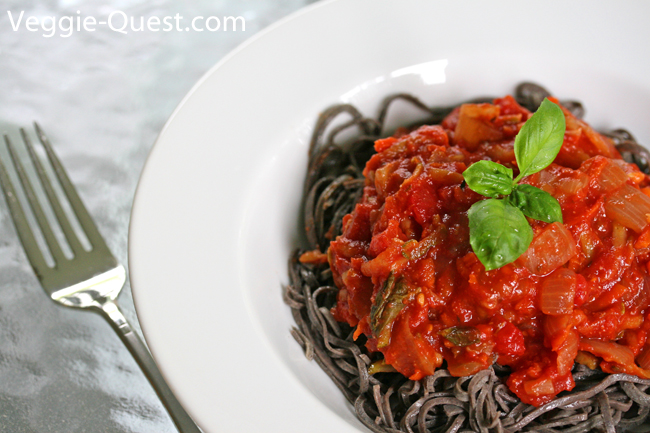
Italian food lovers, rejoice: Marinara sauce is a great way to get iron. Pureed tomatoes contain 4.5 mg iron per cup, plus 27 mg of vitamin C to boost absorption. (4.5 mg iron per 1 cup canned pureed tomatoes)
5. Asparagus
Okay, did anyone else know asparagus is rich in iron? 😉 Because I had no clue. Luckily asparagus is super tasty in veggie sushi or skewered into “rafts” on the grill. (4.4 mg iron per 1 cup canned and drained asparagus)
6. Snap peas
No veggie tray is complete without sweet and crunchy sugar snap peas. They’re also delicious in stir-fries! My favorite brand of sugar snap peas is Mann’s, because they’re stringless. (I also like that the company, despite its name, is woman owned.) 😉 (3.8 mg iron per 1 cup frozen, boiled, and drained edible-podded peas)
7. Baby lima beans
Buttery and delicious, baby lima beans are a go-to side dish around here. Tender with a hint of sweetness, they pair nicely with baked sweet potatoes. All they need is a light sprinkle of salt to be tasty! You can also smash them into a tasty dip with crushed garlic and herbs. Better yet, 1 cup of lima beans has the same protein as two eggs! (3.5 mg iron per 1 cup frozen, boiled and drained baby lima beans)
8. Pumpkin
As if you need another reason to love pumpkin! Here are 7 Gluten-Free and Vegan Pumpkin Recipes to help you get your iron in the most delicious way possible. (3.4 mg iron per 1 cup canned pumpkin)
9. Sweet potato
Another nutrition powerhouse, sweet potatoes are rich in both iron and calcium! Enjoy them in Easy Southern Sweet Potato Salad or Low-Fat Chocolate Frosting. (Mmm…frosting. For the iron. 😉 ) (3.4 mg iron per 1 cup canned, mashed sweet potatoes)
10. Russet potato
As mentioned at the beginning of the post, baked potatoes are a great source of iron. Top them with beans and fresh salsa for even more protein and iron-enhancing vitamin C. (3.2 mg iron per 1 large baked Russet potato with skin)
11. Turnip greens
Yet another superfood that’s packed with minerals, turnip greens also clocked in at #3 on the calcium-rich veggies list. Tired of eating the same old greens? Check out these 10 Vegan Turnip Greens Recipes on Yummly. (3.2 mg iron per 1 cup frozen, boiled, drained turnip greens)
12. Sorrel (dock)
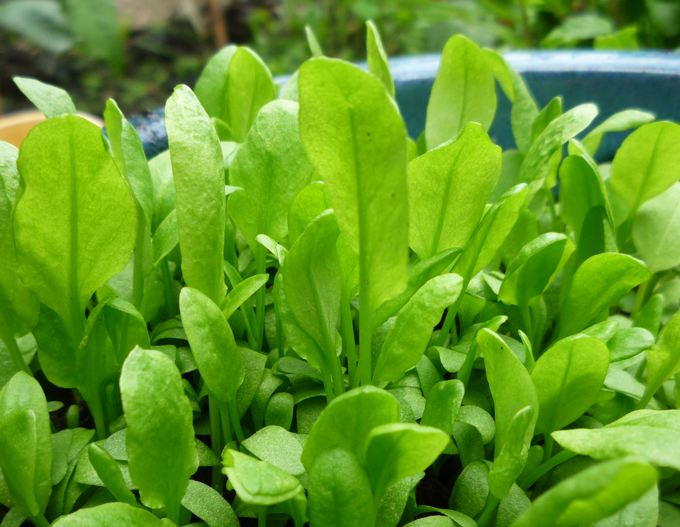
Sorrel by Beck via Flickr
A farmer’s market favorite that’s easy to grow in a home garden, sorrel has a fresh, lemony flavor. We use it to brighten up spring-mix salads, so I was delighted to learn that it also delivers a healthy shot of iron! (3.2 mg iron per 1 cup raw, chopped dock (sorrel))
13. Succotash
Succotash is a mix of lima beans and corn, sometimes with other vegetables for additional flavor. A protein and iron powerhouse, this budget-friendly dish was was a filling favorite during the Great Depression, according to Wikipedia. (2.9 mg iron per 1 cup boiled and drained succotash)
14. Beets
Love ’em or hate ’em, beets really are good for you. Not only do beets deliver a healthy dose of iron, but the pigments that give them their purple-red color are powerful antioxidants.4 Not a beet lover? Try them in these No-Bake Red Velvet Cookies for a pretty, healthy dessert—that doesn’t taste like beets. (2.9 mg iron per 1 cup canned, drained, diced beets)
15. Peas
Who knew that humble peas are rich in iron? Whether blanched and tossed into a vegan alfredo or slow-cooked into mushy peas, these little green gems are packed with big nutrition. (2.7 mg iron per 1 cup seasoned & canned peas with liquid)
16. White mushrooms
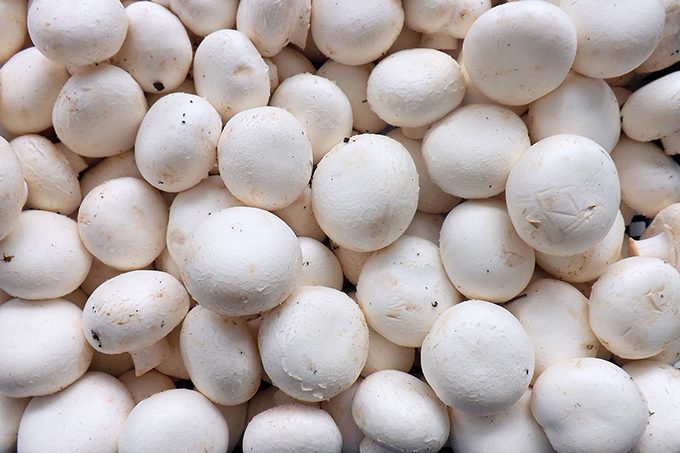
Photo by Hansbenn via Pixabay
One of my favorite ways to add savory umami flavor to any dish, button mushrooms are also a lovely source of iron. (Cool fact: They may also help prevent breast cancer!) Use button mushrooms to top a cheese-free pizza, or make these weeknight-fast Mushrooms with Garlic and Wilted Spinach. (2.7 mg iron per 1 cup boiled and drained)
Your handy cheat sheet
Here’s everything in one place to make life easy…

Pin it for later!
Your turn:
- What’s your favorite iron-rich vegetable? Leave a comment and tell me!
References
1 . Iron: The Double-edged sword. Physicians Committee for Responsible Medicine website. https://www.pcrm.org/health/cancer-resources/diet-cancer/nutrition/iron-the-double-edged-sword.
2. Hallberg L. Bioavailability of dietary iron in man. Annu Rev Nutr. 1981;1:123-47. DOI:
10.1146/annurev.nu.01.070181.001011
3. genannt Bonsmann SS, Walczyk T, Renggli S, Hurrell RF. Oxalic acid does not influence nonhaem iron absorption in humans: a comparison of kale and spinach meals. Eur J Clin Nutr. 2008 Mar;62(3):336-41. Epub 2007 Apr 18. [Abstract only]
4. Smith J. The power of purple: Purple foods provide healthy nutrients and antioxidants. Kansas State University website. https://www.k-state.edu/media/newsreleases/feb11/purplefood20911.html. February 9, 2011. Accessed August 7, 2016.
Shared on the Healthy Living Link Party, Plant-Based Potluck Party, Healthy Vegan Fridays, and Gluten Free Fridays.
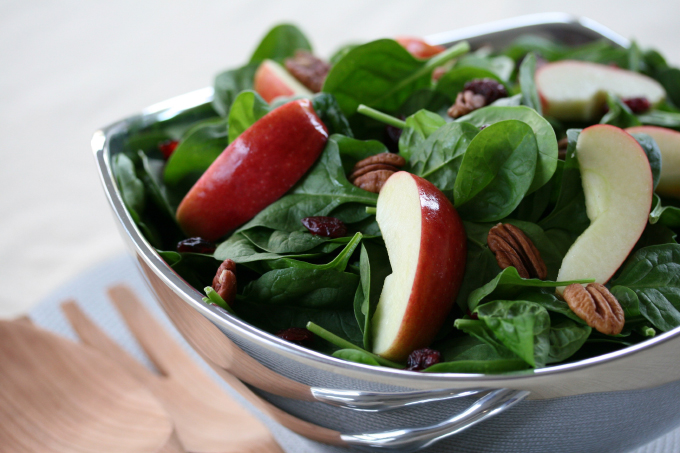
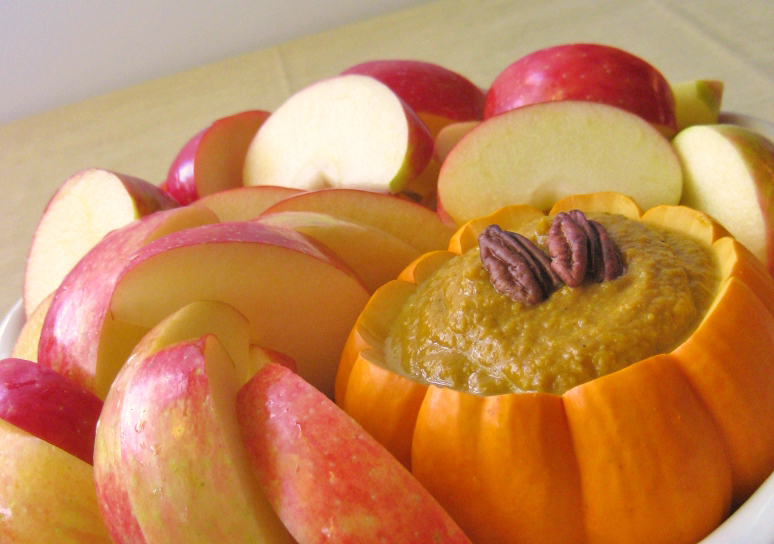


 I'm Lee, an RD thriving on a healthy plant based diet.
I'm Lee, an RD thriving on a healthy plant based diet.
Great and interesting list, Lee–thank you! xo
Thanks Maria! As always, I had fun researching it and found more than a few surprises myself. (I mean, button mushrooms have a lot of iron? Who knew?)
Yeah, that surprised me too–and sugar snap peas–now I have a nutritional excuse to keep eating a ton of those. 🙂
Oh, I LOVE sugar snap peas! Still trying to figure out why they aren’t more mainstream? They’re so crunchy and delicious!
Holy iron batman! This is awesome. I would have never guessed tomato purée would have more iron than meat balls. Yay!
“The non-heme iron in plants? Your body absorbs it only when needed. So if you’re low in iron, your body can snap it up in a jiffy. If you’re all stocked up? Your body can politely say “no thanks.” How cool is that?”
I actually knew this little fact as I have a friend who has hemochromatosis (where your body stores too much iron and you have an excess supply of iron) and I did a little research to let him know he could still safely enjoy plant based forms of iron =) It also absorbs more easily from plants. Yay plants!
Right? I was pretty stoked to find out that canned tomato puree, of all things, was rich in iron. (In fact, it contains more iron than a lot of cuts of steak, too!) That’s crazy that your friend has hemochromatosis. Can he eat plant-based sources of iron with impunity? Or does he still have to eat them within reason?
I should totally replace ketchup with tomato purée… not that I eat ketchup on a regular basis. Or actually buy it ha.
He seems to be fine with plant based iron sources which is nice.
Will you believe me when I say I’ve been checking your blog waiting for this post even more often since we talked about it? It’s true and you did an amazing job. Thank you so much! Much of this I didn’t know before and thanks to you I can now work on my iron situation much more efficiently. I’ll need to figure out the iron content of raw pumpkin/winter squash as it’s my favourite and we don’t get the canned variety over here.
Hi Miss Polkadot! Thanks for checking back, and for the fun post idea. 🙂 I’m glad you learned a lot–I did too!
Also, you can find U.S. government nutrition info for pumpkin cooked in multiple ways (and raw) here. Hope that helps!
Great post Lee! I love all the iron rich info! I have been learning more about it in my Vitamins and Minerals class this semester. I told my friend who was low in iron to put a little lemon juice on her spinach and asparagus to help with absorption and she loved it. 🙂
I had no idea that hearts of palm had lots of iron! I’ll have to use those more. I saw a recipe where someone made “crab” cakes with chopped hearts of palm so maybe I’ll play around with a recipe based on that to make sure I have enough iron.
Isn’t nutrition fascinating? I feel like I could spend days just reading about it. (Okay, I sometimes do.) I love lemon juice on asparagus, but I’ve never tried it on spinach. Will have to give it a go!
I know, the hearts of palm thing surprised me too. Can’t wait to see your “crab” cake recipe! Yum!
At one time I was invited by a Gastroentorologist and was asked just that question and I answered exactly the way you explained it and he dismissed me like a little wet puppy. He still does not believe me, but we are the healthy ones, ha ha
Hi Kerstin, I’m disappointed, but not surprised that he wasn’t aware of the effectively obligate absorption of heme iron. *Sigh* We really need to be teaching nutrition in medical school! You’d think learning about the leading cause of morbidity and mortality would be a meaningful part of the medical school curriculum, but as you and I know, nutrition is practically absent from medical training. :-/
As a lifelong anemic, I need to print this chart out and post it on my refrigerator. It is such a helpful shopping aid. II am so glad you shared your list of 16 iron rich vegetables with us at the Plant-Based Potluck Party. I’m pinning and sharing.
Hi Deborah, I hope the list helps, and I’d be honored to have a spot on your fridge! (That’s primo real estate in my house.) 🙂 Hope you have a great week!
Uncertain, but I believe this article makes it clear that I can eat iron based vegetables while on synthroid (levothyroxine), although iron is cautioned while on prescription Synthroid. I have anemia ,,,,,, so I’m hopeful that this concludes an otherwise difficult dilemma.
I do have enough doctors, that I’ll be keeping in the loop ,,, Thank you,
My Dr told me not to take any iron 4 hours of taking my levothyroxine. I’m guessing that means foods too. I’m anemic and need to start up on iron tablets. I don’t eat good and I know I don’t get the proper nutrients. Reading this article was good but the only thing I like is the baked potatoes. I hate being so picky and probably why I’m anemic. Im a meat & potatoes girl but obviously that’s not enough, or I wouldn’t be low iron. I’m hoping the iron tablets help!!
Amazing tips, veggies are the best
I have just be diagnose with high Iron in my blood what vegtables should I avoid from eating as I like all vegtables
This blog about 16 Iron Rich Vegetables has helped me a lot, is very well
written. I used this fat burner product: https://s96.me/fit and
I reached the ideal weight. Kiss you All!